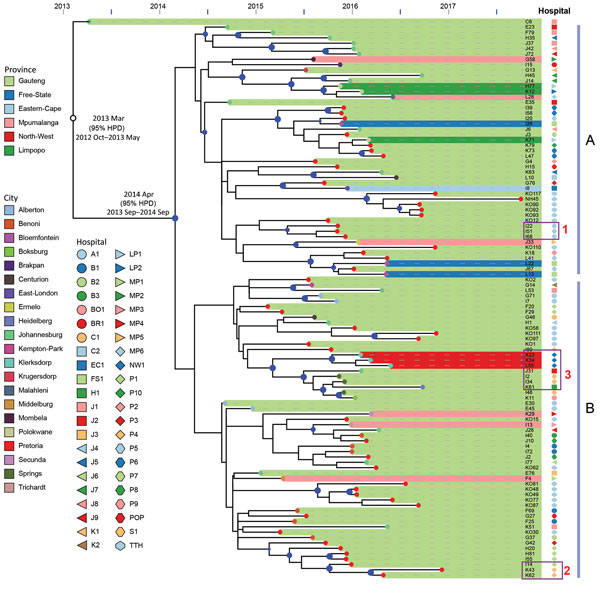Volume 25, Number 4—April 2019
Research
Klebsiella pneumoniae ST307 with blaOXA-181, South Africa, 2014–2016
Figure 4

Figure 4. Bayesian evolution analysis of Klebsiella pneumoniae sequence type (ST) 307 in South Africa hospitals, January 2014–December 2016. A and B indicate the 2 distinct lineages that evolved within Gauteng Province. Highlighted areas depict the provinces from which isolates were obtained, and colored dots at the tips of areas represent the cities from which the isolates were obtained (e.g., for Gauteng Province, Pretoria is red, Johannesburg is green). Dark blue dots at branch points indicate posterior probability >70%, and dot size is proportional to posterior probability values. Hospital locations are indicated as follows; all are private except for Tshwane tertiary hospital: A1, Alberton; J1–J10, Johannesburg; P1–P8, Pretoria; B1–3, Benoni; BO1, Boksburg; BR1, Brakpan; C1–C2, Centurion; EC1, Eastern Cape Province; FS1, Free State Province; K1, Krugersdorp; K2, Kempton Park; LP1–2, Limpopo Province; MP1–6, Mpumalanga Province; NW1, North West Province; S1, Springs; TTH, Tshwane (tertiary hospital). Box 1 shows intrahospital spread: highly related ST307 isolates were obtained from patient I51 and patient I68 in hospital P5. Box 2 shows interhospital spread: patient I14 was transferred from hospital P1 to hospital P4; 3 months later, highly related ST307 was isolated from patient K43 at hospital P4. Box 3 shows intercity and interprovince spread: patient I2 from Springs, patient K61 from Heidelberg, and patient K22 from North West Province, all with highly related ST307 isolates, had previously received medical care at hospital J2 in Johannesburg. HPD, highest posterior density interval; POP, outpatient.
1These authors contributed equally to this article.